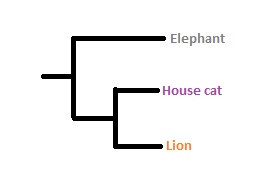 A simple phylogeny - house cats are more closely related to lions than either of them are to elephants.
A simple phylogeny - house cats are more closely related to lions than either of them are to elephants. Scientists represent this as a phylogeny - like a tree of life.
With insects it can be a bit trickier. For one, they can be really tiny! They also sometimes show a lot of convergence - this is when two insects have a body part that looks the same, not because they are closely related, but because they both needed that body part to do the same job. You've probably noticed this in birds, bats and bees - they all have wings, but they're not closely related! They just all evolved wings so that they could fly. So if we were to group animals just based on whether they had wings or not, we wouldn't get a correct idea of their relationship to each other.
These days insect taxonomists often use the help of molecular data as well as morphological. Inside every living thing is genetic information (like DNA or RNA) and by comparing how similar the DNA of a group of insects is, we get an idea of how many species there are and how they are related to each other. There is so much DNA in an insect though, that at the moment it is impractical to use all of it. So scientists working with molecular data tend to use just a few genes (genes = particular lengths of DNA. Jeans = cool denim pants).
Up until a few years ago, most people working on insects would use between three and six genes to build a phylogeny. A journal article (what's a journal article?) published last year used 1,478 genes to build a phylogeny of the insects. 1,478! That's a lot of genes!

 RSS Feed
RSS Feed
